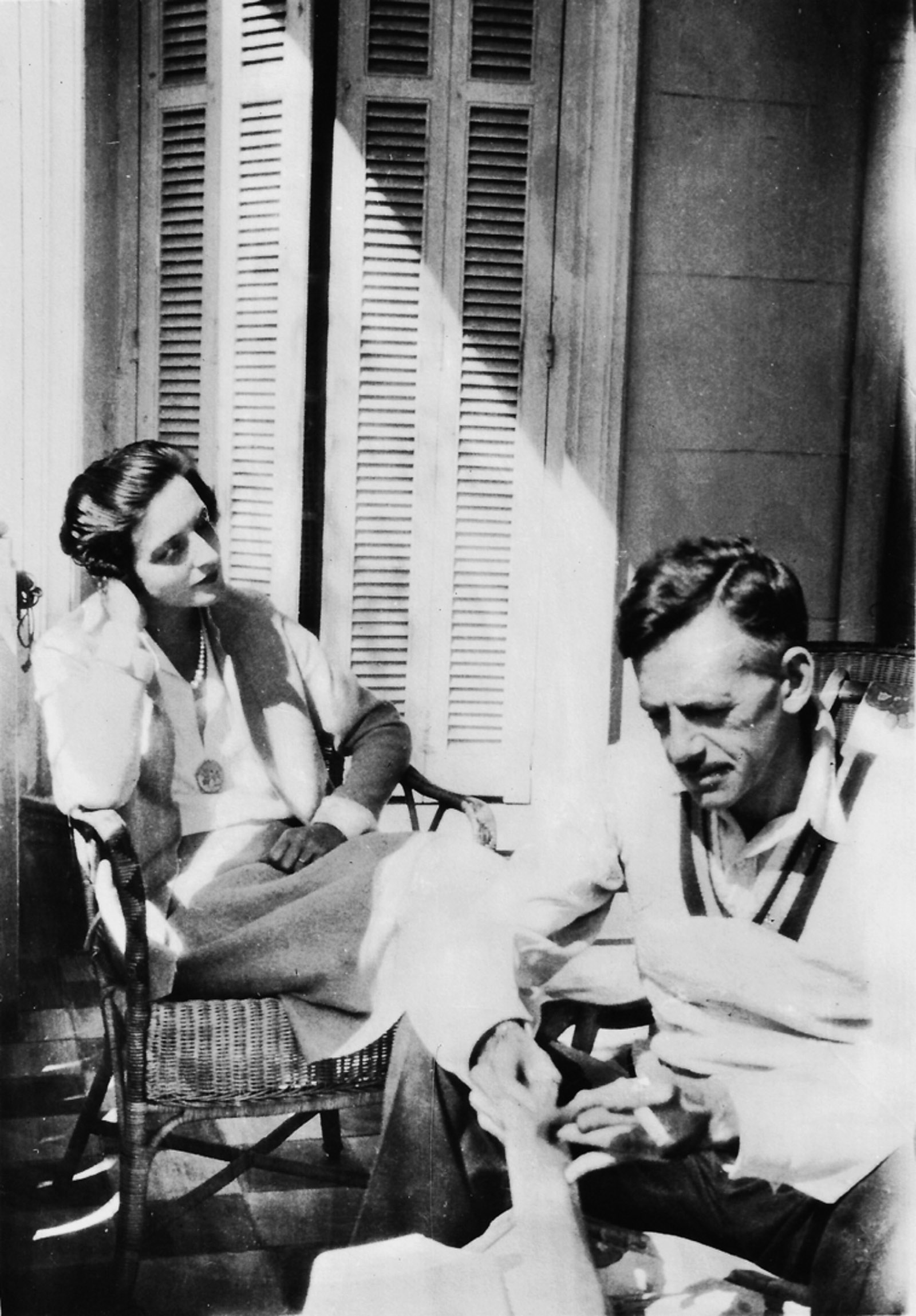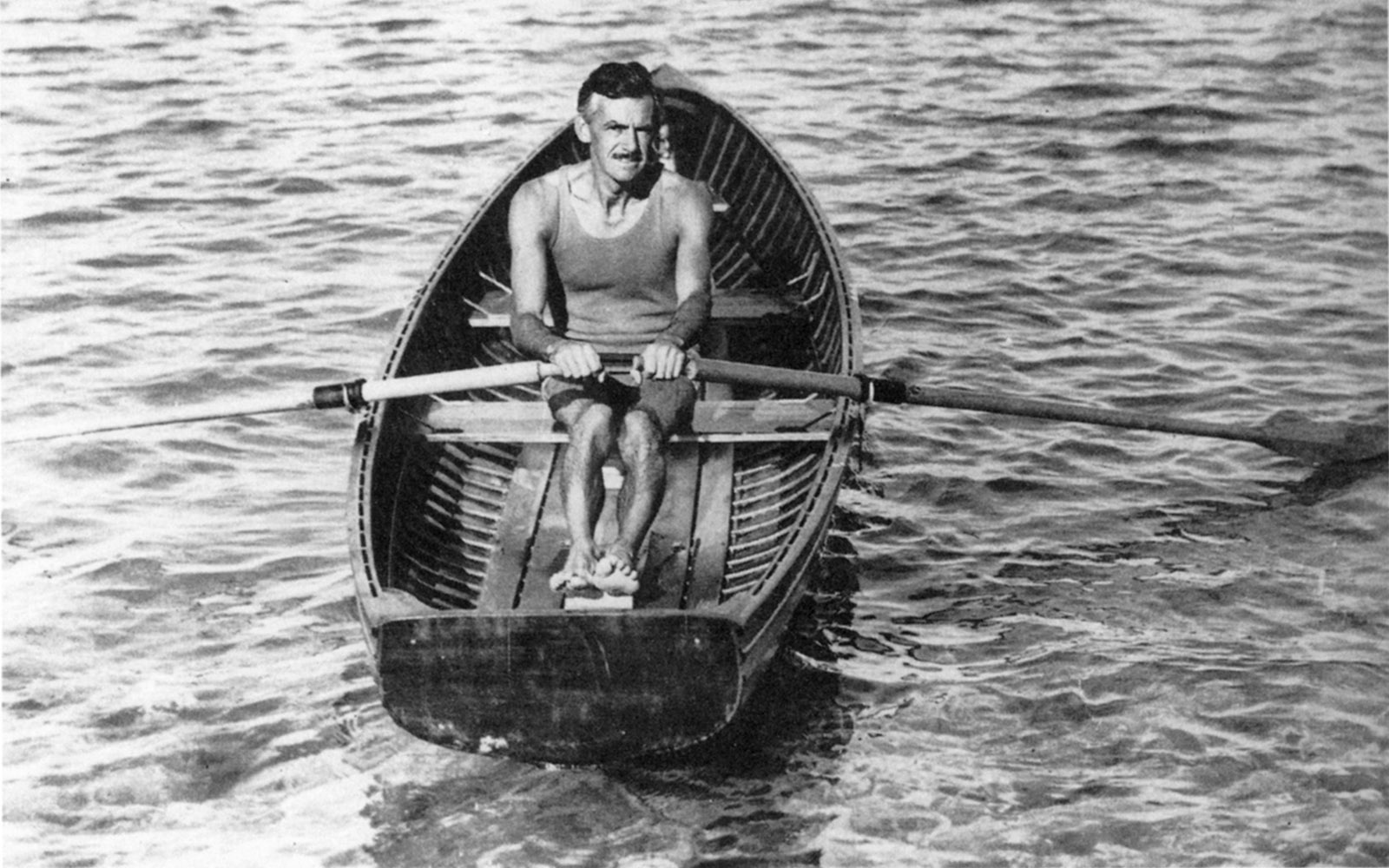Of all the great playwrights, Eugene O’Neill is undoubtedly the worst. At times, even late in his career, he produced work so gauche that without his name on the playbill, one might ascribe it to an overwrought adolescent. In 1936, O’Neill won the Nobel Prize. Just two years earlier, he had produced Days Without End, a drama of religious crisis that is utterly, though alas unintentionally, hilarious. In the climactic scene, the protagonist John Loving, split into two antagonistic halves called John and Loving, wrestles with himself beneath a crucifix in a Catholic church:
John: The Cross!
Loving: The symbol of hate and derision!
John: No! Of love! Mercy! Forgive!
Loving: Fool! Grovel on your knees! It is useless! To pray, one must believe!
John: I have come back to Thee!
The exclamation marks rain down on us like arrows on a medieval battlefield. Where on earth does such preposterous stuff come from? In fact we know exactly where it comes from—The Count of Monte Cristo:
Monte Cristo: I will kill him.
Mercedes: You dare not!
Monte Cristo: Why not?
Mercedes: Because—he is your son!
Monte Cristo: My—!
In his heavily autobiographical masterpiece, Long Day’s Journey into Night, written, as O’Neill put it in the dedication to his third wife, Carlotta, “in tears and blood,” James Tyrone, alter ego of his father James, complains bitterly of “that God-damned play I bought for a song and made such a great success in—a great money success—it ruined me with its promise of an easy fortune.” The God-damned play is The Count of Monte Cristo, a melodramatic stage adaptation by Charles Fechter of Alexandre Dumas’s novel. It is the script of the Faustian pact in which, as O’Neill believed, his family’s soul had been sold for money. James O’Neill was all set to be the greatest American classical actor of his generation, but his star turn as Edmond Dantes was so lucratively popular that he bought out the rights and toured it for almost thirty years.
His son Eugene would come to see the play as the source of all the family’s grief: his father’s prostitution of his talent, the life on the road that turned his genteel mother into a morphine addict, the self-destructive recklessness of his doomed brother Jamie. And in Eugene’s self-image, his own invention of a serious, emotionally grueling American theater was a form of revenge on Monte Cristo and the harm it had done to him:
My early experience with the theater through my father really made me revolt against it. As a boy I saw so much of the old, ranting, artificial, romantic stage stuff that I always had a sort of contempt for the theater.
Yet in 1920, Eugene O’Neill, like a moth drawn to the flame that burned him, thought seriously about writing his own new adaptation of The Count of Monte Cristo. In the end, writers are doomed to be defined at least in part by the stuff they revolt against. O’Neill made himself a great dramatist but he did not do so by banishing the ranting, artificial, garish gestures of the melodrama. He did it by swallowing the melodrama whole. It is always there within his work and sometimes, as in Days Without End, it escapes into the wild and capers ludicrously about the stage. Even in his greatest work, it is a vivid presence. His plots are lurid: Arthur and Barbara Gelb usefully summarize the causes of death of characters in his plays: “suicide, poison, disease, mangling, strangling, hanging, suffocation, knifing, drowning, electrocution, incineration, and gunshot.”
The Iceman Cometh turns on Theodore “Hickey” Hickman’s account of the murder of his long-suffering wife. Two customers in the bar in which he tells the story turn out to be plainclothes policemen who have, amazingly enough, arrived just in time to hear Hickey and arrest him. Another character (Parritt) has betrayed his own mother to the police. Near the end of the play, we hear a “muffled, crunching thud” from offstage as Parritt throws himself from an upstairs window and his body hits the pavement. Even the apparently naturalistic Long Day’s Journey is built around a piece of emotional sensationalism straight out of Charles Dickens: the old man who is too mean to pay for his own son’s treatment for tuberculosis but who has a change of heart after a long night of the soul. In A Touch of the Poet, the dramatic reversal comes when Con Melody is hit on the head and his personality changes. Subtlety is not O’Neill’s game. He did not banish the histrionic style from the American theater. On the contrary, he bedded it down by making it the undersoil of serious art.
Advertisement
This is true, too, of O’Neill’s ideals of acting. There is an official version: O’Neill wanted to be seen as the destroyer of his father’s nineteenth-century theater in which the star was everything and everybody else was there to support the matinee idol or diva. There is no doubt he believed this. He wanted to make the Provincetown Players, for whom he wrote most of his early experimental plays, an American version of the repertory theater movement, in which, as he put it in a program note in 1925, young actors would learn to be “part of a whole, giving their acting a new clear fakeless group excellence and group eloquence that will be our unique acting, our own thing, born in our American theatre as not so long ago Irish acting was born in the Irish Players.”
But did he really want this “sensitive, truthful, trickless acting”? Or was he perhaps rather bored by it, hankering for the blood-and-thunder of the charismatic star? He wrote star parts, after all: Jones in The Emperor Jones, Yank in The Hairy Ape, Hickey in The Iceman, and of course James Tyrone.1 And who would he really have wanted to play Con Melody, the great star role in A Touch of the Poet? His own father, the Monte Cristo matinee idol himself. Intriguingly, he complained to George Jean Nathan that no contemporary actor could play the role of Con, which really needed
an actor like Maurice Barrymore or James O’Neill, my old man. One of those big-chested, chiseled-mug, romantic old boys who could walk onto a stage with all the aplomb and regal splendor with which they walked into the old Hoffman House bar, drunk or sober. Most actors in these times lack an air.
By “an air” he means the commanding, arrogant, radiant presence that sucks toward it all the attention of the audience. So much for the revolt against the ranting, romantic stage stuff. So much for sensitive trickless acting.
In theory, O’Neill wanted the selfless group excellence of the repertory theater. In practice, he loved—and wrote for—the big, charismatic, bravura performer that his father had once been. We should not forget that Paul Robeson played the lead in The Emperor Jones or that no less a star than George M. Cohan happily performed as the father in the premiere of Ah! Wilderness and joked that he and the playwright were going to form a vaudeville double act: “But I come first. It’s got to be Cohan and O’Neill.” It was another actor of regal splendor, Jason Robards, who did so much to restore O’Neill’s battered reputation in the decade after his death in 1953.
This, indeed, is one of the reasons why O’Neill is sometimes so bad. He may have claimed to want self-effacing modern actors, but he didn’t trust them. When O’Neill’s writing is gauche, it is often because he insists on making explicit in the dialogue what a good actor could convey silently through facial expression or physical gesture. Lynn Fontanne, who played Nina Leeds in the premiere of Strange Interlude in 1928, complained of this very tendency:
For instance, I would have to say in an aside something like, “Ned has the bluest eyes I ever saw; I must tell him so.” Then I would go to Ned and tell him he had the bluest eyes I ever saw.
I felt it was unnecessary to say this twice. I told O’Neill it would be better if I looked at Ned’s eyes with admiration the first time, silently, instead of saying the line as an aside. I asked him if I could cut the line. He said, “No you can’t. Play it as I wrote it.”
Fontanne was right: Strange Interlude—all nine acts of it—is spun out to unbearably tedious length because huge chunks of it consist of the characters speaking out loud what ought to be background notes for the actors. O’Neill doesn’t trust them to convey the hidden layers of their existence because he doesn’t really believe in naturalistic acting. For all the contempt he had for his father, he cannot let him go, either as a real person or as an exemplar of the theater. He never really escapes Monte Cristo and in this inability lie both his great failures as a person and a playwright and his great triumphs as an artist.
It seems apt that O’Neill, who wrote at such length, has now been the subject of three huge biographical volumes by the same authors. The husband-and-wife team of Arthur and Barbara Gelb began their research in 1956, published what then seemed the definitive biography in 1962, followed it with the immense O’Neill: Life with Monte Cristo in 2000, and now comes the even longer By Women Possessed, which looks at O’Neill largely through his relationships with his second and third wives, Agnes Boulton and Carlotta Monterey. (Arthur Gelb died in 2014 and Barbara Gelb this February.)
Advertisement
Cumulatively, this makes for more than 2,500 pages of text harvested from a combined century of immersion in O’Neill. It is a magnificent obsession. It is hard to think of anyone who has ever been more thoroughly known from the outside and it is a tribute to the Gelbs’ great skill that their narratives seldom stall under the weight of so much minute detail. But it is also hard to think of anyone who could bear that same weight of revelation of so many dark intimacies without being in some respects diminished. As an artist, O’Neill emerges with his essential heroism intact but as a person, he does not come well out of By Women Possessed. These contrary conclusions grow from the same roots: he is a great artist and in some respects an awful human being because he cannot stop playing out his father’s life.
At one level, for example, O’Neill craved the physical stability he had lacked in his childhood. The “God-damned play” that kept his father on the road gave Eugene a nomadic early existence he purported to despise. Later in life, when his plays were making a lot of money, he continually pictured himself settled in a dream home, with the peace and quiet and sense of routine that would let him get on with his work. The irony that emerges in By Women Possessed is not that he did not achieve such a dream home but that he had so many of them in succession.
His desire for a place of peace could not hold out against his need for the vagabondage of his father’s career. He dragged his wives initially between various parts of Connecticut, New York, and New Jersey, then to Bermuda, the Loire Valley, Sea Island, California, Seattle, and Point O’Rocks near Boston. Time after time, he declares himself finally and fully at home, only to get bored and render himself homeless again. He is on tour. And thus he makes his wives and children repeat the experience that he so blamed his father for inflicting on his mother. In Long Day’s Journey, Eugene’s alter ego Edmund Tyrone savages his father’s treatment of his mother, and in particular the way he “dragged her around on the road” and gave her “no home.” But Eugene’s own wives, and especially Carlotta, put enormous efforts into making homes that were then abandoned. He and Carlotta ended up living in the very hotel rooms that had scarred his childhood, keeping up, as Carlotta complained, “the ridiculous fantasy that this is a home!”
O’Neill made himself the protagonist in the melodrama of his own life. He seemed a beautiful, charming, gentle, sweet-mannered, and lovable man but when Carlotta, in an interview with the Gelbs in 1961, called him “very much a sadist at times,” she was not greatly exaggerating. He did not see family relationships as a repertory company of equal performers. There was one star—himself—and wives and children were supporting actors. His narcissistic self-pity had a sadistic edge. His moods had to be anticipated and accommodated.
He left Agnes because she failed in the protean role he had written for his partner, which was, as Carlotta accepted, to “slip into the mood of that person he needs, at that hour! Wife, mistress, mother, nurse, friend, secretary, his ‘buffer’ to the world. God help me!” Failure to play the right role at the right time was punishable by emotional abuse ranging from cold withdrawal to histrionic ranting, and at times by physical violence. He seems to have assaulted Agnes on many occasions. (The Gelbs, in a rare lapse of taste, claim that she “savored their violent battles.”) He knocked Carlotta flat for the first time shortly after their elopement, calling her a “God-damned whore.” In their later life, he threatened her with a pistol and “began choking her, after which he knocked her out.” Much of this violence was associated with the drinking bouts that punctuated his long periods of sobriety; he knew very well where alcohol led him and chose to go there anyway.
Even more repellent is O’Neill’s treatment of his children Eugene Jr. (by his first wife Kathleen Jenkins), Shane, and Oona (by Agnes). The power of O’Neill’s great plays about his own family, Long Day’s Journey and its companion piece A Moon for the Misbegotten, lies in the profound compassion for the suffering that parents pass on to their children. Edmund and Jamie bear the cross of James and Mary Tyrone’s tragedies. It is hard to understand how the writer who lived and imaginatively relived that suffering could inflict it with such apparent carelessness on his own children. He tortures his children by abandoning them, then drawing them back into his world, then pushing them away again. He has the gall to whine in his letters to them that it is they who have failed him. They are bit-part players who must not usurp his personal epic. There is much more genuine concern evidenced by O’Neill in the Gelbs’ book for his beloved dog Blemie than there is for his own offspring. Eugene Jr. and Shane both died by suicide; Oona eventually drank herself to death.
Yet it is this same inability to break away from the melodramatic histrionics and familial torments that makes O’Neill so potent a playwright. His replaying of his father’s drama is what sustains his sense of being Irish: “One thing,” he told Eugene Jr., “that explains more than anything about me is the fact that I’m Irish.” At one level, his Irishness is all show. He gave his children Irish names, kept an Irish wolfhound and an Irish terrier, made a half-hearted attempt to learn Gaelic, and was thrilled by the esteem of W.B. Yeats, Bernard Shaw, and Sean O’Casey. But he never actually set foot in Ireland.
At another level, though, Irishness matters enormously to his best plays. The Hairy Ape is driven by the rage and shame that arise from racial stereotypes of the Irish. The central characters in his four last great works—The Iceman Cometh, Long Day’s Journey, A Touch of the Poet, and A Moon for the Misbegotten—are Irish emigrants or their children: Larry Slade, the Tyrones, Con Melody, Jamie and Josie Hogan. (For the latter pair, O’Neill held up production of A Moon by insisting that they must be played by actors of Irish descent.) This matters because it is the Irish story rumbling away underneath the action—the dark annals of famine and displacement—that gives grounding and depth to all their lurid extravagances. Of both Josie Hogan and Jamie Tyrone it is said in different plays that they have the map of Ireland stamped on their faces, and the same imprint is on these plays as a whole. O’Neill’s sense of history is a profoundly Irish one and it is this historical sense that turns his melodramas into epics.2
It accounts, too, for the apocalyptic tone of those plays. O’Neill repeatedly spoke of himself as the end of a genetic line: “I am the last of this pure Irish branch of the O’Neills.” This is rather demented and also in part a poor excuse for his dismissal of his own children and grandchildren as not proper O’Neills. But it gives to his best work the potent sensation of forces that have been playing themselves out over many generations coming at last toward their end. Toward his own end, in that astonishing late flourish, his overarching desire is to finish it all with some dignity, not to get out alive but to get out with a death that brings the curtain down on all the cruelties and failures. The last line of his last play, Josie’s prayer for the human wreck Jamie, might have come from a piece of sentimental nineteenth-century hokum that his father could have played in. But O’Neill had earned the right to give it both gravity and grace: “May you rest forever in forgiveness and peace.”
-
1
For a discussion of new productions of The Emperor Jones and The Hairy Ape in New York City this spring, see Geoffrey O’Brien, “O’Neill’s Strange Vaudeville,” NYR Daily, April 3, 2017. ↩
-
2
See my review of O’Neill’s Collected Shorter Plays and John Patrick Diggins’s Eugene O’Neill’s America in these pages, November 8, 2007. ↩





